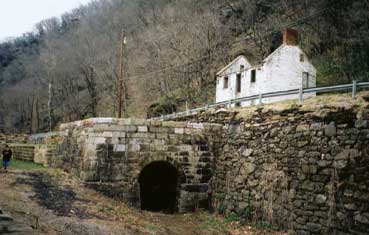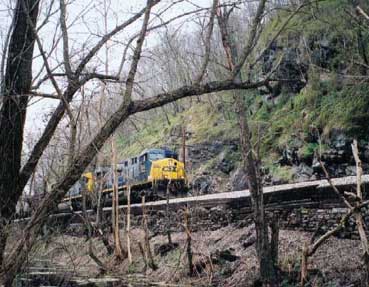 |
| There's a lot more to the C&O Canal than just a long ditch running from Georgetown to the Alleghanies. The tunnel-like structure here is a by-pass flume for the lock that's across the Potomac from Harper's Ferry. In the background are the ruins of an old inn. |
| Building For The Ages The Chesapeake & Ohio Canal and the Baltimore & Ohio Railroad were both started on the same day, July 4, 1828. The canal was cutting edge transportation. Laughable as that statement seems, canal barges could haul a lot more stuff and a lot more cheaply than horse-drawn wagons, land transport that hadn't been improved upon in eons. No one knew what a railroad was in 1828. Which is why President John Quincy Adams chose to attend the canal's groundbreaking rather than the B&O's. The first trains that made their way out of Baltimore, along the Patapsco and Monocacy Rivers south of Frederick were strings of rail-running wagons and stagecoaches pulled by horses. Going over or through mountains was inconceivable. The railroad had to stay level and that meant following the river valleys to the west. At Point-of-Rocks, MD, where a gap in the hills allowed access to the Potomac River, the B&O met the C&O Canal coming up from Georgetown. That meeting began a nasty legal battle for control of the riverbank leading up to Harper's Ferry, WV, the bank, in places, being only a couple hundred feet between the mountains and the water. At one point, the B&O had to slice the heel off a mountain to get by because the canal people were no way going to make room for it or let it build any bridges over the canal. Such right-of-way disputes nationwide meant lots of business for lawyers like Daniel Webster and Abraham Lincoln in the 1830s, '40s and '50s. Peace was made in 1830's when the canal company put a Quaker, as was B&O president, Philip Thomas, in charge. The motive for coexistence was the mutual benefit of both. Imagine business decisions that aim to give all competitors a piece of the pie being made today. It's probably illegal! Back then, there was still some remnant of the ancient moral principle, from the days of feudalism and guilds, that people have not only a right to life, but a right to a livelihood. Another principle now in absentia in commerce was building for the ages. This, too, was borne of a religious urge to leave something for future generations, to help them on their pilgrimage. King Farm, Kentlands and all other such sprawl eruptions are not built for the ages. They are built for people who make money from the building and don't care what happens afterward. If these vertical wastelands don't fall down, they will increase in eyesore-intensity and be torn down for new monstrosities in 20 years. Several viaducts and culverts built of stone by the B&O in the 1830s, including the bridge named for Thomas across the Patapsco at Relay, MD (where they changed horses pulling those early trains), are still taking the daily pounding of rail traffic after 170 years. |
 |
Retaining wall built in the 1830s near Weverton, MD still supports one of the busiest stretches of rail in the U.S. today. C&O Canal bed, here the empire of turtles, is in the foreground. |